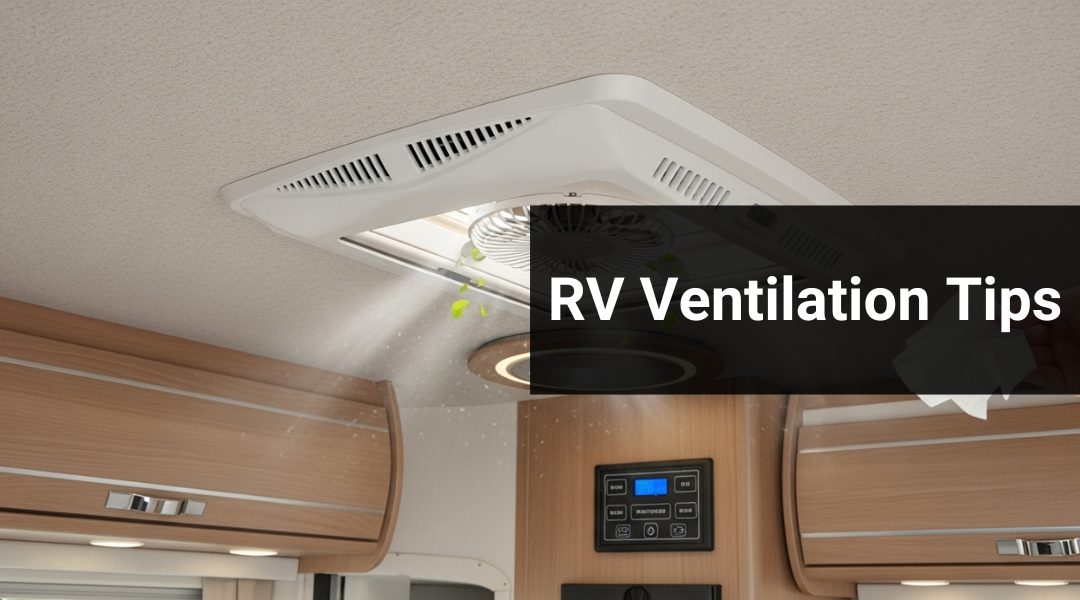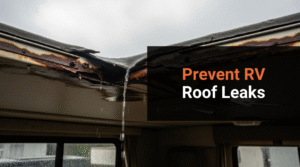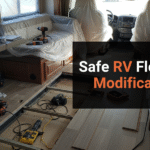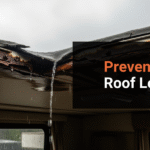Southern California’s sunshine draws you outdoors, but that same heat can quickly turn your RV into an oven if airflow isn’t managed properly. Dry inland air and coastal humidity both challenge your comfort and your vehicle’s interior. Proper RV ventilation keeps temperatures stable, prevents moisture buildup, and protects your investment from costly damage.
When you travel through areas like Huntington Beach, Palm Springs, or San Diego, your RV’s ventilation system becomes just as important as its engine. Simple adjustments—like positioning vents for cross-breeze or upgrading to thermostatic fans—can make long trips far more comfortable while reducing energy use. You’ll also find that maintaining airflow helps your cooling system work more efficiently, saving both wear and cost over time.
This guide explains why poor ventilation becomes a real problem in the Southern California climate and how to fix it. You’ll learn practical ways to improve airflow, avoid common mistakes, and understand when professional upgrades from a trusted local shop like Farace’s Automotive & RV Center make the most sense.
Why Poor RV Ventilation Becomes A Problem In Southern California Heat
Southern California’s climate creates unique challenges for maintaining air quality and temperature control in your RV. Long hours of direct sunlight and fluctuating coastal humidity can quickly turn a comfortable interior into a hot, damp environment that strains both your health and your equipment.
How High Temperatures And Coastal Humidity Affect Your RV’s Interior Comfort And Safety
When outside temperatures climb above 90°F, your RV’s interior can exceed 110°F within minutes if airflow is restricted. Heat buildup stresses the cooling system, accelerates wear on seals and adhesives, and increases the risk of dehydration or heat-related illness.
Humidity from coastal areas compounds the problem. Moist air trapped inside promotes mold growth, condensation, and odors that damage upholstery and electronics.
Use roof vents, open windows on opposite sides, and small fans to maintain circulation. A simple setup—intake vent in front, exhaust vent in back—can reduce interior temperatures by 10–15°F. Regularly cleaning filters and screens ensures that air moves freely and prevents pollutants from accumulating.
How To Improve Airflow And Comfort In Your RV
Efficient ventilation keeps your RV interior cooler, reduces humidity, and prevents stale air buildup. You can achieve better airflow by maintaining vents and fans, improving insulation against heat, and ensuring balanced air movement through proper fan placement and seasonal care.
Step 1: Inspect And Clean Existing Roof Vents And Fans
Start by examining all roof vents and fan housings for dust, cobwebs, and debris. These block airflow and make fans work harder. Use a soft brush or vacuum to remove buildup, then wipe the blades and vent covers with mild soap and water.
Check that vent screens are intact and free from clogging. Replace damaged screens to keep insects out while maintaining airflow. Tighten any loose screws and confirm that fan motors operate smoothly at all speeds.
Inspect the vent seals from the roof. Cracked or worn seals allow air leaks and moisture intrusion. Apply RV-grade sealant around the vent edges if needed. Regular cleaning and inspection every few months help maintain steady ventilation and prevent overheating during Southern California’s warm seasons.
Step 2: Upgrade To High-Efficiency Vent Fans Or Covers For Better Air Circulation
If your RV still uses basic vent fans, upgrading to high-efficiency models can significantly improve airflow. Look for fans with variable speed settings, reversible airflow, and low noise levels. These features let you fine-tune ventilation based on temperature and humidity.
Install vent covers that allow operation even during light rain. This keeps air moving without exposing the interior to moisture. Choose covers with aerodynamic designs to reduce drag and noise while driving.
Many modern fans include thermostat controls that automatically activate when interior temperatures rise. This helps maintain a consistent climate without manual adjustments. When selecting a fan, verify compatibility with your existing vent openings to avoid modification or sealing issues.
Step 3: Use Window Shades And Reflective Materials To Reduce Heat Buildup
Sun exposure quickly raises interior temperatures, especially in Southern California. Install reflective window shades or thermal blinds to block radiant heat. Reflective materials can lower interior heat gain by several degrees, making your ventilation system more effective.
Apply reflective film to large windows or skylights. It reduces UV exposure and glare while maintaining visibility. For a temporary solution, use insulated window covers during peak afternoon hours.
Keep curtains or blinds closed on the sun-facing side of your RV. Combine shading with roof vent operation to pull cooler air in from shaded areas. This method reduces the load on your air conditioner and improves comfort during long daytime stops.
Step 4: Optimize Vent Placement And Fan Direction For Cross-Breeze Efficiency
Cross-ventilation depends on creating airflow paths from intake to exhaust points. Open windows or vents on opposite sides of your RV to allow air to move freely. Use one fan to pull fresh air in and another to push warm air out.
Adjust fan direction based on outdoor conditions. During hot afternoons, set roof fans to exhaust mode to remove rising heat. At night, reverse direction to draw in cooler air. This simple adjustment helps maintain a balanced temperature without extra energy use.
If your RV layout blocks airflow, reposition small portable fans to move air around corners or narrow spaces. Consistent cross-breeze circulation keeps humidity low and prevents stagnant air pockets near sleeping or cooking areas.
Step 5: Schedule Seasonal Maintenance To Keep Ventilation Systems Performing Reliably
Seasonal maintenance ensures your ventilation system continues to perform efficiently. Before summer, clean fan blades, check motor bearings, and confirm that vent covers open and close smoothly. Replace worn gaskets or seals to prevent leaks during rain or washing.
In cooler months, inspect insulation around ducts and vents. Seal gaps that allow drafts or heat loss. Clean or replace air filters in HVAC units to maintain steady airflow and indoor air quality.
Create a simple checklist to track maintenance tasks, including filter changes, vent cleaning, and seal inspections. Regular attention prevents costly repairs and keeps your RV’s ventilation system reliable throughout frequent Southern California travels.
Key Factors That Impact RV Ventilation Costs And Efficiency
Ventilation expenses and performance depend on your RV’s physical layout, the type and quality of fans installed, and how the roof channels air movement. Each of these factors affects how well your system maintains airflow and how much you spend on maintenance or upgrades.
How RV Size, Fan Quality, And Roof Design Influence Airflow And Repair Pricing
Your RV’s size directly affects ventilation needs. Larger rigs require more vents and higher-capacity fans to move air efficiently, which increases both installation and energy costs. Smaller RVs often achieve good airflow with fewer components.

Fan quality plays a key role in efficiency. Higher-grade fans with variable speeds, sealed bearings, and noise reduction features cost more upfront but reduce long-term maintenance and energy use.
Roof design also shapes airflow. Flat or poorly angled roofs can trap heat, while aerodynamic roofs and well-placed vents improve circulation.
| Design Feature | Effect on Airflow | Cost Impact |
|---|---|---|
| Aerodynamic roof | Promotes steady air movement | Moderate installation cost |
| Flat roof | Increases heat buildup | Higher cooling expense |
| Roof vent placement | Enhances cross-ventilation | Varies by model |
Comparing Ventilation Options: Factory Systems Vs. Professional Upgrades
Factory-installed ventilation systems in RVs often provide basic airflow suitable for mild climates, but they can struggle in hot, dry regions like Southern California. Professional upgrades improve air movement, reduce noise, and balance temperature across cabins through better components and optimized ducting.
When To Consider Custom Ventilation Solutions For Older Or Restored RVs
If your RV is over a decade old or recently restored, the original fans and ducts may not meet modern airflow standards. Older systems often rely on small roof vents or weak fans that move limited air volume.
You can replace these with high-capacity roof vent fans, ducted airflow modules, or aftermarket AC diverters that increase airflow efficiency by up to 40%. These upgrades improve cooling performance without increasing energy use.
A simple comparison helps clarify options:
| Feature | Factory System | Professional Upgrade |
|---|---|---|
| Airflow Efficiency | Moderate | High |
| Noise Level | Noticeable | Reduced |
| Installation Effort | Minimal | Moderate |
| Cost | Lower | Higher but more effective |
Upgrading becomes worthwhile when you frequently camp in warm, still air or if your current setup leaves uneven temperatures in different parts of your RV.
Common Ventilation Mistakes RV Owners Make
Small oversights in your RV’s ventilation system can lead to trapped heat, humidity buildup, and poor air quality. Paying attention to airflow, seals, and how you use mechanical systems helps maintain comfort and prevents long-term damage to your vehicle.
Ignoring Seal Leaks, Blocked Vents, Or Underperforming Fans
Air leaks around windows, doors, or roof vents reduce efficiency and make temperature control harder. Even a small gap can let conditioned air escape and allow outside air or moisture to enter. Check seals regularly and replace worn weatherstripping or caulking when cracks appear.
Blocked vents are another frequent problem. Items stored near floor vents, curtains covering wall registers, or debris in roof vents restrict airflow. Keep these areas clear and inspect them during routine cleaning.
Fans that run slowly or make noise often indicate dust buildup or motor wear. Clean fan blades and grilles, and replace filters as needed. If airflow remains weak, consider upgrading to a higher-capacity or variable-speed fan. Properly working fans help remove humidity and odors while supporting even air distribution throughout your RV.
Overusing AC Without Improving Natural Airflow
Running the air conditioner constantly can cool the space but often leaves pockets of stale air. In Southern California’s dry climate, relying only on AC can also waste energy and strain your electrical system. Combine mechanical cooling with natural ventilation for better results.
Use roof vents, windows, and cross-breezes to move air naturally. Opening vents on opposite sides of the RV allows warm air to escape while drawing in cooler air. Roof-mounted vent fans can speed this process without heavy power use.
During cooler mornings or evenings, turn off the AC and open windows. This reduces wear on your HVAC system and keeps indoor air fresher. Maintaining balanced airflow improves comfort and reduces condensation inside your RV.
Why Farace’s Automotive & RV Center Is The Smart Choice In Huntington Beach
You can count on Farace’s Automotive & RV Center for dependable RV maintenance and repair in Huntington Beach. The team combines long-term technical skill with consistent customer service, helping you keep your vehicle safe, efficient, and ready for travel across Southern California.
Veteran-Family-Owned Expertise And 40+ Years Of RV Repair And Restoration Experience
Farace’s Automotive & RV Center has operated since 1976, giving you access to more than four decades of hands-on RV service knowledge. As a veteran-family-owned business, it values reliability, precision, and accountability in every repair or restoration.
Technicians handle a wide range of work, including:
- Roof and body repairs
- Electrical and generator service
- Awnings, appliances, and collision restoration
Their long-standing presence in Huntington Beach means you benefit from technicians who understand local travel conditions, coastal weather, and RV maintenance challenges unique to Southern California. You receive practical solutions that extend your RV’s lifespan and ensure consistent performance on the road.
Farace’s Automotive & RV Center Ventilation Services & Process
Farace’s Automotive & RV Center in Huntington Beach provides certified RV ventilation inspections, repairs, and upgrades designed for Southern California’s warm, coastal climate. You can expect precise diagnostics, high-quality components, and a focus on airflow efficiency that helps maintain comfortable interior temperatures during long trips.
How We Inspect, Repair, And Upgrade RV Ventilation Systems For Southern California Travel
Technicians begin with a detailed inspection of roof vents, fans, and ducting to locate blockages, leaks, or worn seals. They check for corrosion and ensure vents open and close properly to manage airflow and humidity.
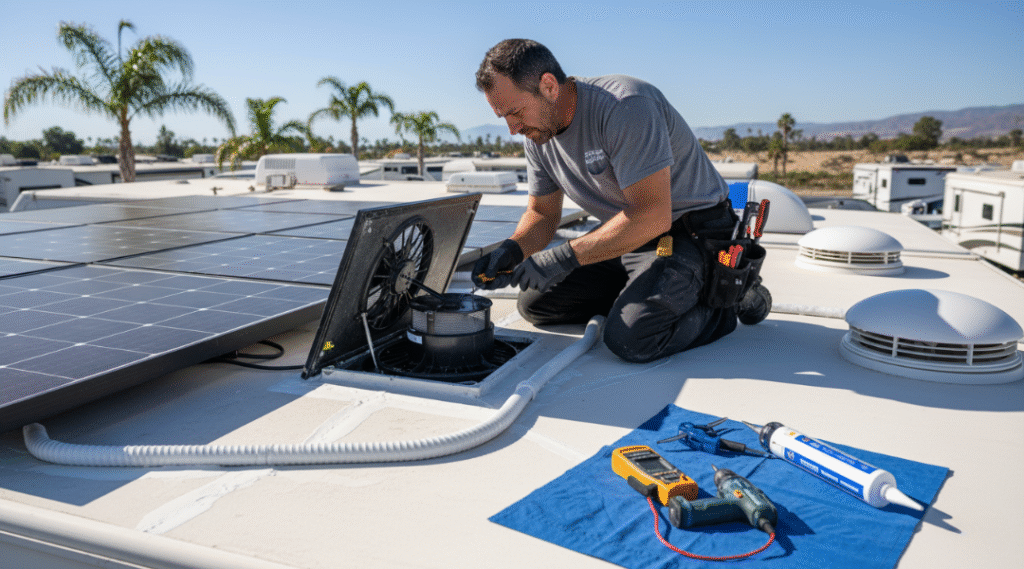
If repairs are needed, damaged vents or motors are replaced with OEM or equivalent-quality parts. Sealants rated for high UV exposure are applied to prevent leaks from coastal moisture.
For upgrades, you can choose high-efficiency vent fans, automatic thermostatic controls, or solar-powered ventilation options suited for extended travel. The team tests each system for balanced airflow and noise control before returning your RV.
| Service Type | Typical Focus | Benefit |
|---|---|---|
| Inspection | Vent seals, fan motors, duct airflow | Prevents moisture and overheating |
| Repair | Replace damaged or corroded parts | Restores proper ventilation |
| Upgrade | Install efficient or solar fans | Improves comfort and energy use |
Conclusion & Next Steps
Proper RV ventilation keeps interior temperatures stable, reduces humidity, and protects your equipment from unnecessary wear. Regular inspections and maintenance help you avoid overheating, condensation, and energy waste while traveling through Southern California’s warm, coastal climate.
Keep Your RV Cool, Safe, And Road-Ready—Contact Farace’s Automotive & RV Center In Huntington Beach For Expert Ventilation Inspection And Service Today
Schedule a professional airflow and ventilation check before your next trip. Technicians at Farace’s Automotive & RV Center inspect vents, fans, and seals to ensure air moves efficiently through your RV.
They can clean or replace filters, test exhaust fans, and verify that roof vents and ducts remain clear. This routine service helps you maintain consistent cooling and heating performance.
Service checklist:
- Vent and duct inspection
- Seal and gasket evaluation
- Fan and motor performance test
- Filter cleaning or replacement
You can book an appointment online or by phone. A well-ventilated RV uses less energy, stays cooler in traffic, and provides a more comfortable environment for every mile you travel.

